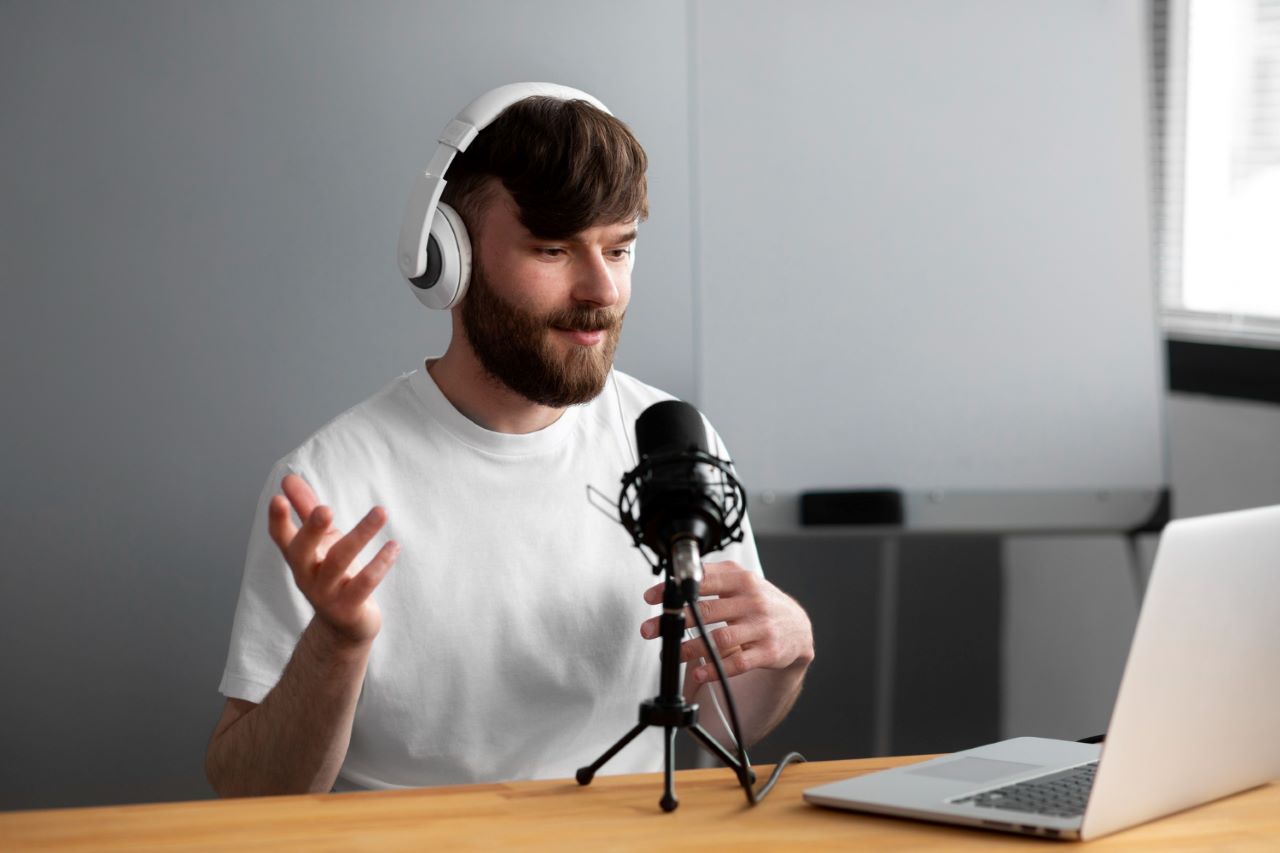Welcome to your ultimate guide for launching a successful podcast. If you’ve ever thought, “I could do that!” while listening to your favorite show, or if you’re an expert looking to share your knowledge with the world, you’re in the right place. Starting a podcast might seem daunting, but don’t worry – this guide will walk you through every step of the way, from conceptualizing your podcast to recording, editing, marketing, and even monetizing your show. And remember, every great podcaster started out just like you: with an idea and a passion to share it.
This podcast checklist isn’t just a series of steps; it’s a journey that will take you from being a podcast fan to becoming a podcast creator. It’s filled with practical advice, insider tips, and lessons from successful podcasters. We’ll cover everything from the basics, like choosing a niche and understanding your target audience, to more advanced topics, like enhancing your podcast with sound effects and music, navigating the world of podcast SEO, and effectively marketing your show.
So whether you’re looking to reach a broader audience for your business, build your personal brand, or simply share your ideas with the world, this guide will help you create a podcast that’s not just another voice in the crowd, but a show that your listeners eagerly await.
Related: Start a Podcast People Will Listen To
Contents
Conceptualizing Your Podcast
Starting a podcast is an exciting endeavor, but to create a successful show, you need a solid foundation. Here’s where conceptualization comes in!
Identifying Your Podcast Niche
The podcasting world is wide and varied, so finding your spot is critical. Why? Because a targeted niche allows you to attract a dedicated listener base, provides a clear focus for your content, and positions you as an authority in your field.
Start by analyzing your interests, current trends, and gaps in the market. Don’t just follow the crowd; consider what unique perspective or knowledge you can bring. One great method is to use tools like Google Trends or Keyword Planner to assess interest in various topics. But remember passion matters. If you love what you’re discussing, it’ll shine through and captivate your audience.
Choosing a podcast niche isn’t a one-and-done deal. It’s an iterative process. Experiment with ideas, research potential audiences, and don’t be afraid to pivot if something isn’t working. Remember: the best podcast niche for you is a combination of your passion and audience interest.
Defining Your Target Audience
Knowing who you’re speaking to is essential. It shapes your content, tone, and marketing strategy. Start by creating a listener persona, detailing demographics, interests, and pain points. Understanding these factors helps you craft content that resonates with them and keeps them coming back for more.
But how can you truly understand your potential listeners? Surveying, conducting social media polls, and exploring forums like Reddit or Quora can provide valuable insights. Remember, your podcast isn’t for everyone, and that’s okay. By focusing on your ideal listener, you’ll create a podcast that truly engages and resonates.
Establishing Your Podcast Format
Now, onto the fun stuff – deciding how your podcast will be presented. Will it be a solo show, co-hosted, interviews, narrative storytelling, or a panel discussion? Each format has its pros and cons, so your choice should align with your content, your comfort zone, and your audience’s preference.
Consider experimenting with different formats in your early episodes to see what works best. Remember to stay consistent once you’ve made your choice – consistency is key to building audience trust and engagement.
Related: How To Start A Podcast Checklist
Planning Your Podcast Episodes
A successful podcast is all about engaging content delivered consistently. And planning is the secret sauce here!
Generating Episode Ideas
Every great podcast starts with a robust content plan. This blueprint guides your podcast’s direction and ensures you’re consistently delivering value to your audience. But where do ideas come from? Everywhere! Current events, audience questions, your niche’s hot topics, or even spin-offs from previous episodes.
Use techniques like mind mapping or brainstorming to generate a list of potential topics. Ensure your content is varied yet cohesive and always relevant to your audience. Regularly review and update your content plan as your own podcast evolves.
Scripting And Storyboarding
Should podcasts be scripted? It’s a heated debate. Overly scripted episodes can sound robotic, while fully unscripted ones risk being rambling and unstructured. Striking a balance is key.
Storyboarding is a great solution. Instead of writing every word, outline your episode’s key points, transitions, and call-to-actions. This keeps you organized and on-point while allowing for a natural delivery. The key is to be prepared but also flexible. After all, great conversation often comes from unplanned moments.
Assembling Your Podcast Gear
Starting a podcast doesn’t require a high-tech recording studio. But investing in the right gear can significantly enhance your audio quality, and that matters to listeners.
Essential Podcast Equipment
When starting, your gear list doesn’t need to be extensive. A good quality microphone, headphones, a pop filter, and audio editing software are the basics. Each piece of equipment plays a critical role in ensuring your podcast’s sound is clear and professional.
If you’re on a budget, plenty of budget-friendly options can give you a great start. As your podcast grows, you can invest in advanced equipment like mixers, portable recorders, or high-end microphones.
Setting Up Your Recording Environment
A dedicated, sound-proof, and distraction-free recording environment is key to achieving great sound quality. But don’t panic if you don’t have a home studio. You can improvise! A quiet room with carpeting or soft furnishings can work. You can even record in a closet!
Investing in some sound-absorbing panels can also be a game-changer, reducing echo and background noise. The key is to experiment with what you have and always prioritize your podcast’s sound quality.
Recording Your Podcast

Image by Freepik
Now, the moment of truth – recording your podcast. Don’t worry; it’s less daunting than it sounds. With a few tips and practices, you’ll be a podcast recording pro in no time!
Podcast Recording Best Practices
Sound quality and consistency matter. You want your listeners to enjoy a seamless experience, regardless of whether they’re listening to your first episode or your fiftieth. Maintaining consistent volume levels, avoiding sudden noises, and using effective voice modulation techniques will all contribute to a better listener experience.
Also, don’t underestimate the power of energy! It’s contagious and keeps your listeners engaged. Use techniques like standing while recording or using hand gestures to infuse more energy into your voice.
Dealing With Guest Speakers
If your podcast format involves guest speakers, there’s more to consider. Firstly, finding and inviting guests who can provide valuable insights for your listeners. Then, make sure they’re prepared for the podcast in terms of topic, format, and technical requirements.
The actual interview requires skill, too. Be a gracious host, make your guest feel comfortable, and guide the conversation in a way that adds value to your listeners. Remember, it’s not just a chat; it’s content your audience should benefit from.
Related: Podcast Mic Setup
Post-Production and Editing
You’ve recorded your podcast – great job! Now, it’s time for post-production magic.
The Art Of Podcast Editing
Editing is critical to ensuring your podcast sounds clean and professional. It’s where you remove awkward silences, “umms”, “ahhs”, and any distracting noises. It’s also where you can enhance your audio quality and add in any intro/outro music or sound effects.
There are several great editing software options, like Audacity, GarageBand, or Adobe Audition. Whichever tool you choose, invest time in learning how to use it effectively. And remember, less is often more with editing. Your goal is to enhance the listening experience, not make your podcast sound unnatural.
Music And Sound Effects
The right music or sound effects can enhance your podcast, creating mood and signaling transitions. But tread carefully. It’s essential to use royalty-free music or sounds, or you risk copyright infringement.
Several sites offer royalty-free audio, like Free Music Archive or AudioJungle.
Use music and sound effects sparingly and ensure they align with your podcast’s tone and branding. They should enhance, not distract.
Podcast Branding And Marketing
You have your podcast ready, and it sounds great. But how do you get people to listen? That’s where branding and marketing come in!
Creating A Podcast Brand
Strong branding can set your podcast apart in a sea of content. It’s more than just a catchy name and logo; it’s about creating a unique identity that resonates with your audience and reflects your podcast’s content and tone.
Creating a podcast brand involves choosing a memorable name, designing an eye-catching logo, crafting a compelling tagline, and developing a consistent visual and audio style. Your branding should be reflected everywhere your podcast is present, from podcast directories to social media to your website.
Marketing Your Podcast
Now, it’s time to get your podcast heard. Marketing your podcast effectively involves leveraging various channels – from social media to email marketing to SEO – to reach potential listeners.
Promote your episodes consistently, engage with your audience, collaborate with other podcasters, and don’t shy away from asking for reviews or shares. Remember, podcasting isn’t a “publish it, and they will come” game. It requires ongoing, strategic effort to grow your listener base.
Launching And Distributing Your Podcast

Image by Freepik
The big day is almost here! But before you hit “publish,” there’s a bit more prep work to do.
Preparing For The Podcast Launch
Launching with multiple episodes can help hook your listeners right away. It gives them a chance to dive deep into your content, which can lead to higher engagement and more subscriptions.
Build anticipation before your launch. Use your website, social media channels, and email list to get people excited about what’s coming. Set a launch date and stick to it. A successful launch can set the tone for your podcast’s ongoing success.
Podcast Distribution Platforms
Where you host and distribute your podcast matters. Popular platforms like Apple Podcasts, Spotify, and Google Podcasts are essential for reaching a wide audience. But each platform has its own pros and cons, so do your research.
The uploading process varies across platforms, so familiarize yourself with each platform’s requirements. Most importantly, ensure your podcast’s metadata (like title, description, and category) is SEO-optimized to help listeners find your show.
Sustaining And Growing Your Podcast
Launching your podcast is just the beginning. Maintaining consistency, engaging with your audience, and exploring monetization options are all keys to growing your podcast.
Maintaining Consistency
Regular podcast releases are key to keeping your audience engaged. Create a content calendar and recording routine to ensure you’re consistently delivering fresh content. And remember, every podcaster faces creative blocks. When they happen, don’t panic. Take a break, seek inspiration, and remember why you started podcasting in the first place.
Engaging With Your Audience
Audience engagement can turn listeners into loyal fans. Reply to comments, shout out to listeners on your episodes, and actively seek feedback. Not only does this make your listeners feel valued, but their insights can also help you improve your podcast.
Monetizing Your Podcast
There are several ways to monetize a podcast, from sponsorships to ads to listener donations. Before you jump into monetization, consider your audience size, engagement, and how different monetization methods might impact the listener experience. Read our post, How to Make Money Podcasting, for a comprehensive guide.
Common Podcasting Mistakes To Avoid
Even the most seasoned podcasters make mistakes. But being aware of these common pitfalls can help you avoid them.
1. Technical Errors
Technical errors can turn your dream podcast into a listening nightmare. From poor sound quality to inconsistent audio levels to botched editing, such issues can significantly disrupt the listening experience and turn away potential audience members.
Taking the time to understand and resolve common technical issues is crucial. Here are some typical errors and how to combat them:
- Poor Sound Quality: This can be due to using low-quality equipment or recording in a noisy environment. Invest in a decent microphone and create a sound-proof, quiet space for recording.
- Inconsistent Audio Levels: This is when the volume varies greatly, forcing listeners to adjust their volume continuously. Use editing software to normalize your audio levels.
- Bad Editing: Over-editing can make your podcast sound unnatural, while under-editing might leave in unnecessary portions, causing a break in flow. Learn basic editing skills or consider hiring a professional editor for a seamless listening experience.
Remember, always conduct a test recording before you start an actual episode. This way, you can identify and fix any potential issues beforehand.
2. Content-Related Mistakes
In the world of podcasting, content is king. However, creating content that doesn’t resonate with your audience or straying from your niche can lead to disengagement and a decline in listenership. Your content should always reflect your audience’s interests and expectations. Here are some mistakes to avoid:
- Deviation from the Niche: Once you’ve chosen a niche, stick to it. Deviating from your theme can confuse your audience and dilute your brand.
- Lack of Preparation: Lack of preparation can result in content that lacks depth and engagement. Always research your topic thoroughly and prepare a clear, concise outline before recording.
- Ignoring Audience Feedback: Your audience can offer valuable insights into what they want from your podcast. Ignoring their feedback can lead to producing content that doesn’t resonate with them.
Keep your content focused, well-researched, and audience-led for a successful podcasting journey.
3. Marketing And Engagement Missteps
Marketing and audience engagement are essential components for growing your podcast. Neglecting to promote your podcast, ignoring audience engagement, or not leveraging SEO can lead to missed opportunities for growth.
To avoid these, develop a robust marketing and engagement strategy and adjust it as you learn what works and what doesn’t. Here are some key mistakes to avoid:
- Not Promoting Your Podcast: Use multiple channels – social media, email newsletters, guest appearances on other podcasts – to spread the word about your podcast.
- Ignoring Audience Engagement: Engagement is a two-way street. Respond to comments, ask for feedback, and create a community around your podcast.
- Not Leveraging SEO: SEO isn’t just for written content. Make your podcast easily discoverable by optimizing your show notes, episode titles, and descriptions with relevant keywords.
Remember, the key to a successful podcast lies not only in creating great content but also ineffective marketing and engagement strategies. Keep learning, keep evolving, and you’ll see your podcast grow.
4. Neglecting Show Notes
Neglecting show notes is a common pitfall in the world of podcasting. Show notes serve as a summary or transcription of your podcast episode. They provide extra value for your listeners by offering additional insights, links to resources mentioned during the episode, timestamps for key points, and more.
When you neglect show notes, you’re missing out on a valuable tool for audience engagement and SEO. These notes not only provide added value to your listeners but they also make your podcast more discoverable by search engines. Here’s how:
- SEO Benefits: Including keywords in your show notes can help your podcast appear in relevant search results, bringing more visitors to your website or podcast hosting service platform.
- Audience Value: By providing links to resources and more in-depth information, your show notes can deepen the relationship with your listeners, encouraging them to engage with you and your content further.
To make the most out of your show notes, ensure they are clear, well-structured, and packed with relevant information. Including a call-to-action (CTA), like asking for ratings and reviews, can also help boost your podcast’s visibility and engagement.
5. Inconsistent Audio Quality
Audio quality plays a vital role in podcasting. When your audio quality is inconsistent, it can be a distraction for your listeners and might lead them to stop tuning in. Your listeners shouldn’t have to adjust their volume constantly or strain to hear you because of poor audio quality.
- Equipment Matters: Invest in a good microphone and use sound editing software to ensure a consistent sound across your episodes.
- Recording Environment: Be mindful of where you are recording. Background noise echoes or poor acoustics can affect the audio quality of your audio files.
You don’t need a professional recording studio to produce a great-sounding podcast. With the right equipment and quiet, well-set-up space, you can ensure a consistent audio experience for your listeners.
6. Not Asking For Reviews Or Feedback
Ignoring the power of reviews and feedback is a common podcasting mistake. Reviews not only help you improve your show based on listener feedback but also boost your visibility on podcast platforms.
- Boost Visibility: Most podcast platforms, like Apple Podcasts and Spotify, use algorithms that favor shows with more reviews and ratings. So, the more reviews you have, the more likely your podcast is to be recommended to new listeners.
- Improve Your Show: Feedback can help you understand what your listeners like or dislike about your show, which can be valuable for improving future episodes.
Don’t be shy about asking your listeners to leave a review or rate your podcast. You can do this at the end of your episodes or through your social media channels.
By avoiding these common podcasting mistakes, you’re on your way to creating a successful, engaging show that resonates with your listeners. From show notes to audio quality to reviews and feedback, each element plays a vital role in your podcast’s success. So, stay focused, and keep improving.
Related: Best Books On Podcasting
FAQs
What are the 3 Features of a Podcast?
Podcasts have become a popular form of entertainment and education due to a variety of unique features. Here are three key features of a podcast:
1. On-Demand and Convenient
One of the primary features of a podcast is its on-demand nature. Listeners can stream or download episodes and listen to them whenever they want. This convenience makes it possible for people to listen while commuting, exercising, or doing chores.
2. Versatile Content
Podcasts can cover a wide range of topics, from business and education to entertainment and personal stories. The versatility of content allows creators to reach a specific niche audience, while listeners can find a podcast on virtually any subject that interests them.
3. Engaging and Personal
Podcasts often have a more personal and engaging nature compared to other media. Listeners feel a close connection to the podcast host as they listen to their voice directly in their ears. Moreover, the long-form content allows for deep dives into topics, which can be more engaging and informative for the listener.
How Can I Identify Gaps in the Podcast Market For My Niche?
Identifying gaps in the podcast market involves researching and understanding the current landscape within your chosen niche. Here are a few steps:
- Listen to Existing Podcasts in Your Niche: Understand what topics are already covered extensively and identify subjects that are not being discussed in detail.
- Engage with Your Target Audience: Use social media, online forums, or survey tools to understand what your potential listeners want to learn about but can’t find in existing podcasts.
- Analyze Trends: Use tools like Google Trends or Buzzsumo to identify trending topics in your niche that haven’t been adequately covered in podcasts.
- Leverage Your Unique Perspective: Consider what unique experiences, insights, or expertise you can bring to your niche that others can’t.
How Can Podcast SEO Improve My Podcast’s Discoverability?
SEO (Search Engine Optimization) can significantly improve your podcast’s discoverability by making it easier for potential listeners to find your show. Here’s how:
- Podcast Title and Description: Incorporate keywords relevant to your content in your podcast title and description.
- Episode Titles and Show Notes: Use keywords in episode titles and show notes. Make sure to write detailed, keyword-rich show notes for each episode.
- transcripts: Provide transcripts of your episodes. This not only improves accessibility but also gives search engines more text to crawl.
- Backlinks: Promote your podcast on your own blog, guest posts, or social media to increase backlinks to your podcast site.
Remember, SEO is a long-term strategy and it takes time to see results.
Conclusion
Starting a podcast is a journey filled with learning, experimentation, and growth. It can seem daunting, but remember: every successful podcaster started where you are now. With a clear vision, good planning, and a commitment to delivering value to your audience, you’ll be well on your way to podcasting success.



